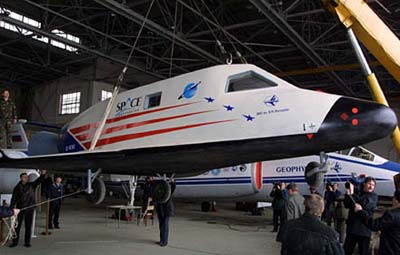Why did Space Adventures buy Space Launch Corporation?by Taylor Dinerman
|
| When Virgin Galactic and Space Adventures end up competing to fly tourists on these flights to 100 kilometers or more above the Earth, it will be a make-or-break moment for the whole space tourism industry. |
Space Launch has been working on several US Government-funded projects, including the now-abandoned RASCAL (Responsive Access Small Cargo Affordable Launch) and has developed some interesting expertise in reusable first stage systems as part of possible two-stage-to-orbit vehicles. A reusable first stage is technologically awfully close to a suborbital spaceplane such as Burt Rutan’s SpaceShipOne and the next-generation one he is now building for Virgin Galactic.
Eric Anderson, CEO of Space Adventures, wants to get into the suborbital tourist business and compete with Virgin Galactic. He reportedly hopes to be able to use either or both the Xerus vehicle that XCOR is working on or a version of the Cosmopolis 21 vehicle, dubbed Explorer, that Russia’s Myasishchev Design Bureau is developing. Both vehicles will be able to carry between two to six people on suborbital tourist flights.
When Virgin Galactic and Space Adventures end up competing to fly tourists on these flights to 100 kilometers or more above the Earth, it will be a make-or-break moment for the whole space tourism industry. Either they will both find enough paying customers to keep their operations going and bring the prices down to a point where more and more people will be happy to pay for the experience, or they will quickly exhaust the supply of potential space tourists. If it becomes a success, and both ventures find that there are not only enough curious thrill seekers, but that some of their customers want to repeat the experience as often as possible, then the industry will have developed the solid footing that it needs to thrive throughout the 21st century.
What Space Launch can do to give Space Adventures a chance to compete with Virgin Galactic and its Rutan-designed vehicles is to support XCOR and Myasishchev to insure that both vehicles are safe and robust enough. In the case of the Russians this is going to be difficult since ITAR regulations certainly apply to Space Launch. However with patience—and a few good lawyers—the ITAR obstacles might be overcome.
If the Russian vehicle is good enough it might be possible for Space Adventures to want to bring one or more over to the US and have them licensed to US standards. From a legal point of view it would be a smaller-scale version of what Boeing does with Sea Launch. The Explorer and its derivatives might just be the next big Russian space success story or yet another failed space plane proposal, so far there is no way of knowing. The same goes for XCOR’s Xerus and for SpaceDev’s Dream Chaser, for that matter.
| What is significant is that there is more movement in the industry than there has been for quite a few years. |
All these firms, and many others, are building suborbital craft with the hope that someday their vehicles will evolve into ones that can reach orbit. The Holy Grail of the RLV industry, a radical reduction in the cost of launching payloads and people into orbit, is still out there. It perhaps may be beyond today’s state of the art, but close enough so that the right design, combined with the right breakthrough in propulsion or materials technology, could make it a reality.
What is significant is that there is more movement in the industry than there has been for quite a few years. Rutan’s SpaceShipOne, like the DC-X before it, showed what could be done. Investors are cautious, and before any significant private money goes into these vehicles there is a real need for technologically-savvy due diligence. This is where Space Launch could pay off, providing services to investors in much the same way the Aerospace Corporation serves the Pentagon.
Space Adventures says it is going to keep a “Chinese Wall” between themselves and Space Launch. This is a good idea for many reasons, but above all because it will give the clients of Space Launch confidence that they are buying services from a company whose orientation is technical, rather than one whose indisputable strength is marketing and sales.
